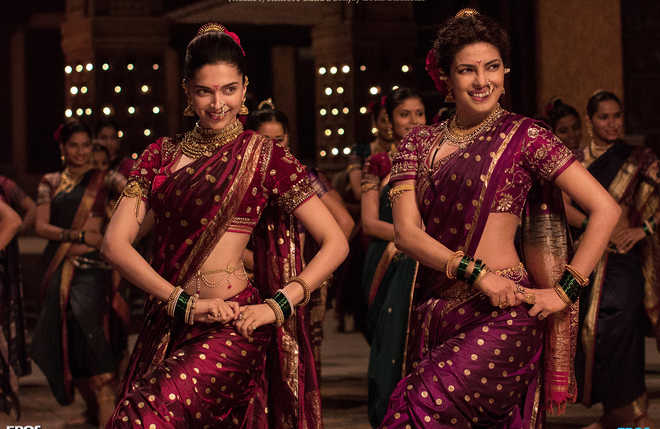Shoma A. Chatterji
A descendant of Peshwa Bajirao I has alleged that historical facts have been “altered” while portraying the late king and his wives Kashibai and Mastani in Sanjay Leela Bhansali’s Bajirao Mastani. Also a petition was filed stating that the song ‘Pinga’ is offensive to the Marathi culture. A descendant of queen Kashibai Peshwa, who didn’t wish to be named, claimed that Kashibai suffered from an arthritis-like ailment at a very young age and was bedridden for most of her life. She also suffered from asthma, and hence, it was impossible for her to have danced with Mastani.
The question, here, is not so much about the commercial success or failure of historical romances but is more about the extent to which such films reflect the historical conditions and contexts of these romances. Also how much these are based on authentic sources and whether these are a part of what has come to be termed as “contextual film history.”
Placed within the context of Bollywood films, such questions do not arise for the simple reason that these are made with two targets — to fulfil the demands of the mass audience, cutting through caste, class, language and geography and to fill in the coffers at the cash counter. It is interesting to find that the popular films supposedly rooted in love stories picked from history, most of the love stories use only the names of the characters, the historical backdrop and grand production design and locations for their films.
The two most famous films based on the same historical romance between Salim (later became Jehangir) and Anarkali, namely Anarkali (1953) and Mughal-e-Azam (1960) are said to be fictional because Anarkali has been created and did not exist. Art historian R. Nath has argued that Jehangir had no wife Anarkali to whom the emperor could have built a tomb. There is no evidence that Prince Salim ever fell in love with the courtesan, and no reference to her in Salim’s autobiography. Whether Anarkali is pure fiction or based on a historical fact, her legend has mesmerised the people. She has caught the eye of nearly every big name in the arts in South Asia for the past 100 years. Anarkali and Mughal-e-Azam were major hits in Pakistan and India.
An off-mainstream director like Ketan Mehta did not blink before putting in entirely fictionalised love stories in his film Mangal Pandey — The Rising (2005). Mangal Pandey was a sepoy, whose actions helped spark the First War of Independence in 1857. But the two stories of the romantic liaisons between the British commanding officer William Gordon and Jwala, a teenaged widow he saves from being burnt as a sati, is pure fiction as is the romance between Mangal and Hira, whom he marries before being executed.
The film made decent business but faced controversy. The BJP demanded a ban on the film accusing it of character assassination of Mangal Pandey. Samajwadi Party leader Uday Pratap Singh called in the Rajya Sabha to ban the film for its “inaccurate portrayal” of Mangal Pandey.
Protesters in Ballia district, where Pandey had lived, damaged a shop selling cassettes and CDs of the film, stalled a goods train on its way to Chapra (Bihar), and staged a sit-in on the Ballia-Barriya highway. But the film continued to run and did reasonable business.
Prof. Irfan Habib, former chairman of the Indian Council of Historical Research, talking about the truth of the love story of Jodhaa-Akbar presented by Ashutosh Gowarikar asserts that there was no historical character named Jodha Bai. It is true that Akbar married Amber king Raja Bharmal’s eldest daughter but her name is not mentioned anywhere. Even Jehangir has not mentioned anything about this woman in his memoirs Tuzuk-i-Jahangir. According to N R Farooqi, head of the Department of History at of Allahabad University, Jodha was not Akbar’s wife but Jahangir’s and she was Shah Jahan’s mother.
Are historical films authentic? Jodhaa-Akbar, Anarkali, Mughal-e-Azam, Bajirao Mastani and similar films render these questions redundant. True, that a magical blend of history, fiction and fantasy does not offer space to the audience for identification. But, according to Frederick Jackson Turner, “each age tries to form its own conception of the past. Each age writes the history of the past anew with reference to the conditions uppermost in its own time.” The entertainment value, the lavish sets, the beautiful costumes, the music, the song and the dance numbers, the dramaturgy, the aesthetically picturised locations and the brilliant acting by the lead performers transport us to a world of fantasy that transcends the confines of time so closely that you can stretch your hand and touch the time.
Unlock Exclusive Insights with The Tribune Premium
Take your experience further with Premium access.
Thought-provoking Opinions, Expert Analysis, In-depth Insights and other Member Only Benefits
Already a Member? Sign In Now










